历年诺贝尔化学奖获奖者介绍【1951】 GlennT.Seaborg
历届诺贝尔化学奖获得者名单及贡献
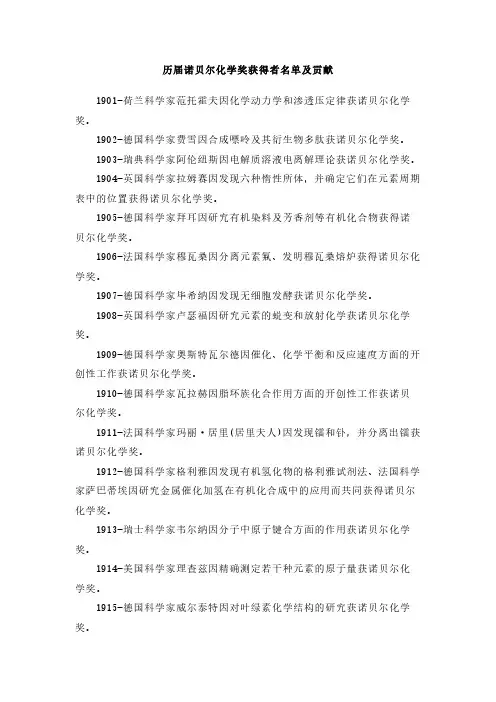
历届诺贝尔化学奖获得者名单及贡献1901-荷兰科学家范托霍夫因化学动力学和渗透压定律获诺贝尔化学奖。
1902-德国科学家费雪因合成嘌呤及其衍生物多肽获诺贝尔化学奖。
1903-瑞典科学家阿伦纽斯因电解质溶液电离解理论获诺贝尔化学奖。
1904-英国科学家拉姆赛因发现六种惰性所体,并确定它们在元素周期表中的位置获得诺贝尔化学奖。
1905-德国科学家拜耳因研究有机染料及芳香剂等有机化合物获得诺贝尔化学奖。
1906-法国科学家穆瓦桑因分离元素氟、发明穆瓦桑熔炉获得诺贝尔化学奖。
1907-德国科学家毕希纳因发现无细胞发酵获诺贝尔化学奖。
1908-英国科学家卢瑟福因研究元素的蜕变和放射化学获诺贝尔化学奖。
1909-德国科学家奥斯特瓦尔德因催化、化学平衡和反应速度方面的开创性工作获诺贝尔化学奖。
1910-德国科学家瓦拉赫因脂环族化合作用方面的开创性工作获诺贝尔化学奖。
1911-法国科学家玛丽·居里(居里夫人)因发现镭和钋,并分离出镭获诺贝尔化学奖。
1912-德国科学家格利雅因发现有机氢化物的格利雅试剂法、法国科学家萨巴蒂埃因研究金属催化加氢在有机化合成中的应用而共同获得诺贝尔化学奖。
1913-瑞士科学家韦尔纳因分子中原子键合方面的作用获诺贝尔化学奖。
1914-美国科学家理查兹因精确测定若干种元素的原子量获诺贝尔化学奖。
1915-德国科学家威尔泰特因对叶绿素化学结构的研究获诺贝尔化学奖。
1916-1917-1918-德国科学家哈伯因氨的合成获诺贝尔化学奖。
1919-1920-德国科学家能斯脱因发现热力学第三定律获诺贝尔化学奖。
(1921年补发)1921-英国科学家索迪因研究放射化学、同位素的存在和性质获诺贝尔化学奖。
1922-英国科学家阿斯顿因用质谱仪发现多种同位素并发现原子获诺贝尔化学奖。
1923-奥地利科学家普雷格尔因有机物的微量分析法获诺贝尔化学奖。
1924-1925-奥地利科学家席格蒙迪因阐明胶体溶液的复相性质获诺贝尔化学奖。
历年诺贝尔化学奖得主
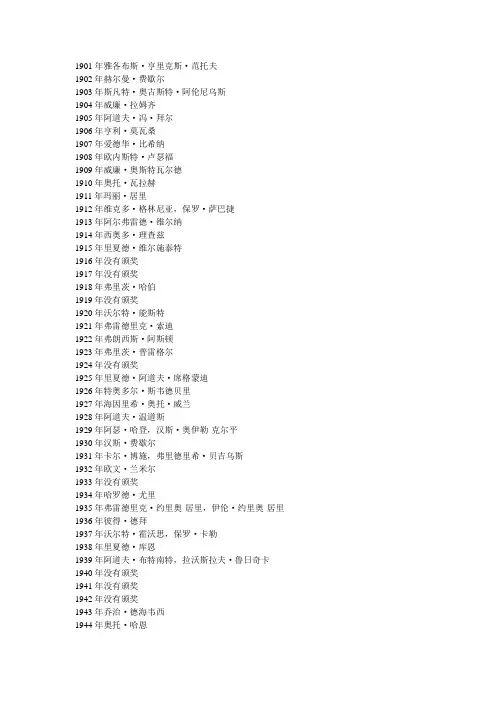
1901年雅各布斯·亨里克斯·范托夫1902年赫尔曼·费歇尔1903年斯凡特·奥古斯特·阿伦尼乌斯1904年威廉·拉姆齐1905年阿道夫·冯·拜尔1906年亨利·莫瓦桑1907年爱德华·比希纳1908年欧内斯特·卢瑟福1909年威廉·奥斯特瓦尔德1910年奥托·瓦拉赫1911年玛丽·居里1912年维克多·格林尼亚,保罗·萨巴捷1913年阿尔弗雷德·维尔纳1914年西奥多·理查兹1915年里夏德·维尔施泰特1916年没有颁奖1917年没有颁奖1918年弗里茨·哈伯1919年没有颁奖1920年沃尔特·能斯特1921年弗雷德里克·索迪1922年弗朗西斯·阿斯顿1923年弗里茨·普雷格尔1924年没有颁奖1925年里夏德·阿道夫·席格蒙迪1926年特奥多尔·斯韦德贝里1927年海因里希·奥托·威兰1928年阿道夫·温道斯1929年阿瑟·哈登,汉斯·奥伊勒-克尔平1930年汉斯·费歇尔1931年卡尔·博施,弗里德里希·贝吉乌斯1932年欧文·兰米尔1933年没有颁奖1934年哈罗德·尤里1935年弗雷德里克·约里奥-居里,伊伦·约里奥-居里1936年彼得·德拜1937年沃尔特·霍沃思,保罗·卡勒1938年里夏德·库恩1939年阿道夫·布特南特,拉沃斯拉夫·鲁日奇卡1940年没有颁奖1941年没有颁奖1942年没有颁奖1943年乔治·德海韦西1944年奥托·哈恩1945年阿尔图里·伊尔马里·维尔塔宁1946年詹姆士·萨姆纳,约翰·霍华德·诺思罗普,温德尔·斯坦利1947年罗伯特·鲁宾逊1948年阿尔内·蒂塞利乌斯1949年威廉·吉奥克1950年奥托·迪尔斯,库尔特·阿尔德1951年埃德温·麦克米伦,格伦·西奥多·西博格1952年阿彻·约翰·波特·马丁,理查德·劳伦斯·米林顿·辛格1953年赫尔曼·施陶丁格1954年莱纳斯·鲍林1955年文森特·迪维尼奥1956年西里尔·欣谢尔伍德,尼古拉·谢苗诺夫1957年亚历山大·R·托德1958年弗雷德里克·桑格1959年雅罗斯拉夫·海罗夫斯基1960年威拉德·利比1961年梅尔文·卡尔文1962年马克斯·佩鲁茨,约翰·肯德鲁1963年卡尔·齐格勒,居里奥·纳塔1964年多萝西·克劳福特·霍奇金1965年罗伯特·伯恩斯·伍德沃德1966年罗伯特·马利肯1967年曼弗雷德·艾根,罗纳德·乔治·雷伊福特·诺里什,乔治·波特1968年拉斯·昂萨格1969年德里克·巴顿,奥德·哈塞尔1970年路易斯·费德里克·勒卢瓦尔1971年格哈德·赫茨贝格1972年克里斯琴·伯默尔·安芬森,斯坦福·摩尔,威廉·霍华德·斯坦1973年恩斯特·奥托·菲舍尔,杰弗里·威尔金森1974年保罗·弗洛里1975年约翰·康福思,弗拉迪米尔·普雷洛格1976年威廉·利普斯科姆1977年伊利亚·普里高津1978年彼得·米切尔1979年赫伯特·布朗,格奥尔格·维蒂希1980年保罗·伯格,沃特·吉尔伯特,弗雷德里克·桑格1981年福井谦一,罗德·霍夫曼1982年阿龙·克卢格1983年亨利·陶布1984年罗伯特·布鲁斯·梅里菲尔德1985年赫伯特·豪普特曼,杰尔姆·卡尔1986年达德利·赫施巴赫,李远哲,约翰·波拉尼1987年唐纳德·克拉姆,让-马里·莱恩,查尔斯·佩特森1988年约翰·戴森霍费尔,罗伯特·胡贝尔,哈特穆特·米歇尔1989年西德尼·奥特曼,托马斯·切赫1990年艾里亚斯·詹姆斯·科里1991年理查德·恩斯特1992年鲁道夫·马库斯1993年凯利·穆利斯,米高·史密斯1994年乔治·安德鲁·欧拉1995年保罗·克鲁岑,马里奥·莫利纳,弗兰克·罗兰1996年罗伯特·柯尔,哈罗德·克罗托,理查德·斯莫利1997年保罗·博耶,约翰·沃克尔,延斯·克里斯汀·斯科1998年沃特·科恩,约翰·波普1999年艾哈迈德·兹韦勒2000年艾伦·黑格,艾伦·麦克迪尔米德,白川英树2001年威廉·诺尔斯,野依良治,巴里·夏普莱斯2002年库尔特·维特里希,约翰·贝内特·芬恩,田中耕一2003年彼得·阿格雷,罗德里克·麦金农2004年阿龙·切哈诺沃,阿夫拉姆·赫什科,欧文·罗斯2005年罗伯特·格拉布,理查德·施罗克,伊夫·肖万2006年罗杰·科恩伯格2007年格哈德·埃特尔2008年下村脩,马丁·查尔菲,钱永健2009年阿达·约纳特,万卡特拉曼·莱马克里斯南,托马斯·施泰茨2010年理查德·赫克,根岸英一,铃木章2011年丹·谢赫特曼2012年罗伯特·莱夫科维茨,布莱恩·克比尔卡。
历年诺贝尔化学奖

发展了使用碳14同位素进行年代测定的方法
1961年:梅尔温·卡尔文
研究了植物对二氧化碳的吸收,以及光合作用
1962年:马克斯·佩鲁茨,,约翰·肯德鲁
研究了肌红蛋白的结构
1963年:卡尔·齐格勒,朱里奥·纳塔
对聚合物的研究,齐格勒-纳塔聚合
1964年:多罗西·克劳富特·霍奇金(Dorothy Crowfoot Hodgkin,英国)
1929年:亚瑟·哈登, 汉斯·奥伊勒-克尔平
对糖类的发酵以及发酵酶的研究和探索
1930年:汉斯.费歇尔
对血红素和叶绿素等的研究
1931年:卡尔·博施, 弗里德里希·柏吉斯
在高压化学合成技术上的贡献
1932年:兰格缪尔
对表面化学的研究
1934年:哈罗德·尤里
发现了氘
1990年:伊莱亚斯·科里
开发了计算机辅助有机合成的理论来自方法 1991年:理乍得·恩斯特
对开发高分辨率核磁共振(NMR)的贡献
1992年:罗道夫·阿瑟·马库斯
对创立和发展电子转移反应的贡献
1993年:凯利·穆利斯, 迈克尔·史密斯
对DNA化学的研究,开发了聚合酶链式反应(PCR)
1938年:理乍得·库恩
对类胡罗卜素和维生素的研究
1939年:阿道夫·弗雷德里希·Johann·布特南特, 利奥波德·Ruzicka
对性激素的研究 以及 对聚亚甲基和高萜烯的研究
1940年:未发奖。
1941年:未发奖。
1942年:未发奖。
1943年:格奥尔格·赫维西
对在化学变化中使用同位素作为失踪物的研究
1979年:赫伯特·布朗, 乔治·维蒂希
历年诺贝尔化学奖得主19502008二
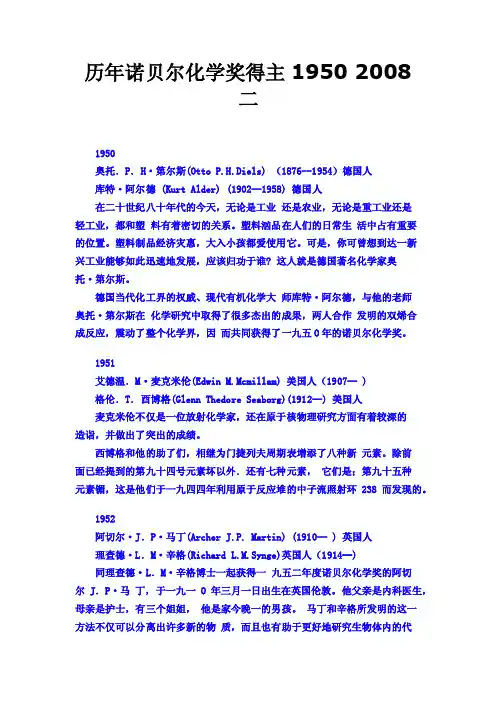
历年诺贝尔化学奖得主1950 2008二1950奥托.P.H·第尔斯(Otto P.H.Diels) (1876--1954)德国人库特·阿尔德 (Kurt Alder) (1902--1958) 德国人在二十世纪八十年代的今天,无论是工业还是农业,无论是重工业还是轻工业,都和塑料有着密切的关系。
塑料汹品在人们的日常生活中占有重要的位置。
塑料制品经济灾惠,大入小孩都爱使用它。
可是,你可曾想到达一新兴工业能够如此迅速地发展,应该归功于谁? 这人就是德国著名化学家奥托·第尔斯。
德国当代化工界的权威、现代有机化学大师库特·阿尔德,与他的老师奥托·第尔斯在化学研究中取得了很多杰出的成果,两人合作发明的双烯合成反应,震动了整个化学界,因而共同获得了一九五O年的诺贝尔化学奖。
1951艾德温.M·麦克米伦(Edwin M.Mcmillam) 美国人(1907-- )格伦.T.酉博格(Glenn Thedore Seaborg)(1912--) 美国人麦克米伦不仅是一位放射化学家,还在原于核物理研究方面有着较深的造诣,并做出了突出的成绩。
西博格和他的助了们,相继为门捷列夫周期表增添了八种新元素。
除前面已经提到的第九十四号元素坏以外.还有七种元素,它们是;第九十五种元素镅,这是他们于一九四四年利用原于反应堆的中子流照射环238而发现的。
1952阿切尔·J.P·马丁(Archer J.P. Martin) (1910-- ) 英国人理查德·L.M·辛格(Richard L.M.Synge)英国人(1914--)同理查德·L.M·辛格博士一起获得一九五二年度诺贝尔化学奖的阿切尔J.P·马丁,于一九一O年三月一日出生在英国伦敦。
他父亲是内科医生,母亲是护士,有三个姐姐,他是家今晚一的男孩。
马丁和辛格所发明的这一方法不仅可以分离出许多新的物质,而且也有助于更好地研究生物体内的代谢路线。
历届诺贝尔化学奖得主简介
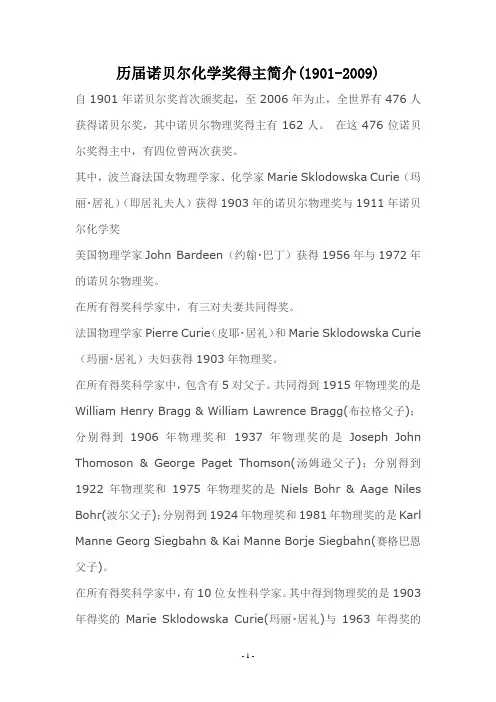
历届诺贝尔化学奖得主简介(1901-2009)自1901年诺贝尔奖首次颁奖起,至2006年为止,全世界有476人获得诺贝尔奖,其中诺贝尔物理奖得主有162人。
在这476位诺贝尔奖得主中,有四位曾两次获奖。
其中,波兰裔法国女物理学家、化学家Marie Sklodowska Curie(玛丽‧居礼)(即居礼夫人)获得1903年的诺贝尔物理奖与1911年诺贝尔化学奖美国物理学家John Bardeen(约翰‧巴丁)获得1956年与1972年的诺贝尔物理奖。
在所有得奖科学家中,有三对夫妻共同得奖。
法国物理学家Pierre Curie(皮耶‧居礼)和Marie Sklodowska Curie (玛丽‧居礼)夫妇获得1903年物理奖。
在所有得奖科学家中,包含有5对父子。
共同得到1915年物理奖的是William Henry Bragg & William Lawrence Bragg(布拉格父子);分别得到1906年物理奖和1937年物理奖的是Joseph John Thomoson & George Paget Thomson(汤姆逊父子);分别得到1922年物理奖和1975年物理奖的是Niels Bohr & Aage Niles Bohr(波尔父子);分别得到1924年物理奖和1981年物理奖的是Karl Manne Georg Siegbahn & Kai Manne Borje Siegbahn(赛格巴恩父子)。
在所有得奖科学家中,有10位女性科学家。
其中得到物理奖的是1903年得奖的Marie Sklodowska Curie(玛丽‧居礼)与1963年得奖的Maria Goeppert Mayer(玛丽雅‧梅耶)。
在所有得奖科学家中,有6位是华裔科学家。
分别是1957年物理奖的杨振宁和李政道;1976年物理奖的丁肇中;1986年得化学奖的李远哲;1997年得物理奖的朱棣文;1998年得物理奖的崔琦。
历届诺贝尔化学奖获得者名单及贡献
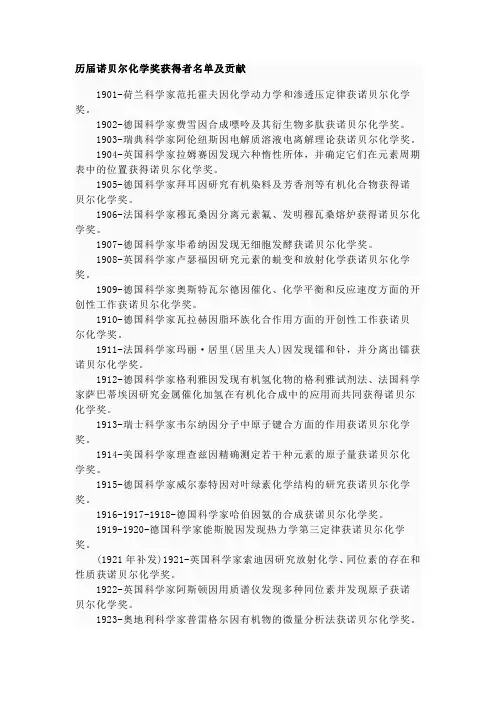
历届诺贝尔化学奖获得者名单及贡献1901-荷兰科学家范托霍夫因化学动力学和渗透压定律获诺贝尔化学奖。
1902-德国科学家费雪因合成嘌呤及其衍生物多肽获诺贝尔化学奖。
1903-瑞典科学家阿伦纽斯因电解质溶液电离解理论获诺贝尔化学奖。
1904-英国科学家拉姆赛因发现六种惰性所体,并确定它们在元素周期表中的位置获得诺贝尔化学奖。
1905-德国科学家拜耳因研究有机染料及芳香剂等有机化合物获得诺贝尔化学奖。
1906-法国科学家穆瓦桑因分离元素氟、发明穆瓦桑熔炉获得诺贝尔化学奖。
1907-德国科学家毕希纳因发现无细胞发酵获诺贝尔化学奖。
1908-英国科学家卢瑟福因研究元素的蜕变和放射化学获诺贝尔化学奖。
1909-德国科学家奥斯特瓦尔德因催化、化学平衡和反应速度方面的开创性工作获诺贝尔化学奖。
1910-德国科学家瓦拉赫因脂环族化合作用方面的开创性工作获诺贝尔化学奖。
1911-法国科学家玛丽·居里(居里夫人)因发现镭和钋,并分离出镭获诺贝尔化学奖。
1912-德国科学家格利雅因发现有机氢化物的格利雅试剂法、法国科学家萨巴蒂埃因研究金属催化加氢在有机化合成中的应用而共同获得诺贝尔化学奖。
1913-瑞士科学家韦尔纳因分子中原子键合方面的作用获诺贝尔化学奖。
1914-美国科学家理查兹因精确测定若干种元素的原子量获诺贝尔化学奖。
1915-德国科学家威尔泰特因对叶绿素化学结构的研究获诺贝尔化学奖。
1916-1917-1918-德国科学家哈伯因氨的合成获诺贝尔化学奖。
1919-1920-德国科学家能斯脱因发现热力学第三定律获诺贝尔化学奖。
(1921年补发)1921-英国科学家索迪因研究放射化学、同位素的存在和性质获诺贝尔化学奖。
1922-英国科学家阿斯顿因用质谱仪发现多种同位素并发现原子获诺贝尔化学奖。
1923-奥地利科学家普雷格尔因有机物的微量分析法获诺贝尔化学奖。
1924-1925-奥地利科学家席格蒙迪因阐明胶体溶液的复相性质获诺贝尔化学奖。
《Nobel Prize for Chemistry》
1901-19991901Jacobus Henricus van 't Hoff(The Netherlands,30.8.1852 - 1.3.1911)Germany, Berlin University,"in recognition of the extraordinary services he hasrendered by the discovery of the laws of chemicaldynamics and osmotic pressure in solutions".1902Hermann Emil Fischer(Germany, 9.10.1852 -15.7.1919)Germany, Berlin University,"in recognition of the extraordinary services he hasrendered by his work on sugar and purine syntheses".1903Svante August Arrhenius (Sweden, 19.2.1859 -2.10.1927)Sweden, Stockholm University,"in recognition of the extraordinary services he hasrendered to the advancement of chemistry by hiselectrolytic theory of dissociation".Nobel Prize for Chemistry1904Sir William Ramsay (Great Britain, 2.10.1852 -23.7.1916)Great Britain, London University,"in recognition of his services in the discovery of the inert gaseous elements in air, and his determination of their place in the periodic system".1905Johann Friedrich Wilhelm Adolf von Baeyer (Germany, 31.10.1835 - 20.8.1917)Germany, Munich University,"in recognition of his services in the advancement of organic chemistry and the chemical industry, through his work on organic dyes and hydroaromatic compounds".1906Henri Moissan (France, 28.9.1852 - 20.2.1907) France, Sorbonne University, Paris,"in recognition of the great services rendered by him in his investigation and isolation of the element fluorine, and for the adoption in the service of science of the electric furnace called after him".1907Eduard Buchner (Germany, 20.5.1860 - 13.8.1917) Germany, Landwirtschaftliche Hochschule, (Agricultural College), Berlin,"for his biochemical researches and his discovery of cellfree fermentation".1908Sir Ernest Rutherford (Nelson, New Zealand,30.8.1871 - 19.10.1937)Great Britain, Victoria University, Manchester,"for his investigations into the disintegration of the elements, and the chemistry of radioactive substances". 1909Wilhelm Ostwald (Riga, then Russia, 2.9.1853 -4.4.1932)Germany, Leipzig University,"in recognition of his work on catalysis and for his investigations into the fundamental principles governing chemical equilibria and rates of reaction".1910Otto Wallach (Germany, 27.3.1847 - 26.2.1931) Germany, Goettingen University,"in recognition of his services to organic chemistry and the chemical industry by his pioneer work in the field of alicyclic compounds".1911Marie Curie, née Sklodowska (Warsaw, Poland,7.11.1867 - 4.7.1934)France, Sorbonne University, Paris,"in recognition of her services to the advancement of chemistry by the discovery of the elements radium and polonium, by the isolation of radium and the study of the nature and compounds of this remarkable element".1912The Prize was divided equally between:Victor Grignard (France, 16.5.1871 - 13.12.1935) France, Nancy University,"for the discovery of the so-called Grignard reagent, which in recent years has greatly advanced the progress of organic chemistry";andPaul Sabatier (France, 5.11.1854 - 14.8.1941) France, Toulouse University,"for his method of hydrogenating organic compounds in the presence of finely disintegrated metals whereby the progress of organic chemistry has been greatly advanced in recent years".1913Alfred Werner (Mulhouse, Alsace, then Germany, 12.12.1866 - 15.11.1919)Switzerland, Zürich University,"in recognition of his work on the linkage of atoms in molecules by which he has thrown new light on earlier investigations and opened up new fields of research especially in inorganic chemistry".1914Theodore William Richards (USA, 31.1.1868 -2.4.1928)USA, Harvard University, Cambridge, MA,"in recognition of his accurate determinations of the atomic weight of a large number of chemical elements".1915Richard Martin Willstätter (Germany, 13.8.1872 - 3.8.1942)Germany, Munich University,"for his researches on plant pigments, especially chlorophyll".1916The prize money was allocated to the Special Fund of this prize section1917The prize money was allocated to the Special Fund of this prize section1918Fritz Haber (Germany, 9.12.1868 - 29.1.1934) Germany, Kaiser-Wilhelm-Institut (nowFritz-Haber-Institut) für physikalische Chemie und Electrochemie, Berlin-Dahlem,"for the synthesis of ammonia from its elements".1919The prize money was allocated to the Special Fund of this prize section1920Walther Hemann Nernst (Germany, 25.6.1864 -18.11.1941)Germany, Berlin University,"in recognition of his work in thermochemistry".1921Frederick Soddy (Great Britain, 2.9.1877 - 22.9.1956) Great Britain, Oxford University,"for his contributions to our knowledge of the chemistry of radioactive substances, and his investigations into the origin and nature of isotopes".1922Francis William Aston (Great Britain, 1.9.1877 -20.11.1945)Great Britain, Cambridge University,"for his discovery, by means of his mass spectrograph, of isotopes, in a large number of non-radioactive elements, and for his enunciation of the whole-number rule".1923Fritz Pregl (Austria, 3.9.1869 - 13.12.1930)Austria, Graz University,"for his invention of the method of micro-analysis of organic substances".1924The prize money was allocated to the Special Fund of this prize section1925Richard Adolf Zsigmondy (Vienna, Austria, 1.4.1865 - 29.9.1929)Germany, Goettingen University,"for his demonstration of the heterogenous nature of colloid solutions and for the methods he used, which have since become fundamental in modern colloid chemistry".1926Theodor Svedberg (Sweden, 30.8.1884 - 26.2.1971) Sweden, Uppsala University,"for his work on disperse systems".1927Heinrich Otto Wieland (Germany, 4.6.1877 - 5.8.1957) Germany, Munich University,"for his investigations of the constitution of the bile acids and related substances".1928Adolf Otto Reinhold Windaus (Germany, 25.12.1876 -9.6.1959)Germany, Goettingen University,"for the services rendered through his research into the constitution of the sterols and their connection with the vitamins".1929The Prize was divided equally between:Sir Arthur Harden (Great Britain, 12.10.1861 -17.6.1940)Great Britain, London University,andHans Karl August Simon von Euler-Chelpin (Augsburg, Germany, 15.2.1873 - 6.11.1964) Sweden, Stockholm University,"for their investigations on the fermentation of sugar and fermentative enzymes".1930Hans Fischer (Germany, 27.7.1881 - 31.3.1945) Germany, Technische Hochschule (Institute of Technology), Munich,"for his researches into the constitution of haemin and chlorophyll and especially for his synthesis of haemin". 1931The Prize was awarded jointly to:Carl Bosch (Germany, 27.8.1874 - 26.4.1940) Germany, Heidelberg University and I.G. Farbenindustrie A.G., Heidelberg,andFriedrich Bergius (Germany, 11.10.1884 - 30.3.1949) Germany, Heidelberg University and I.G. Farbenindustrie A.G. Mannheim-Rheinau,"in recognition of their contributions to the invention and development of chemical high pressure methods". 1932Irving Langmuir (USA, 31.1.1881 - 16.8.1957)USA, General Electric Co., Schenectady, NY,"for his discoveries and investigations in surface chemistry".1933The prize money was with 1/3 allocated to the Main Fund and with 2/3 to the Special Fund of this prize section.1934Harold Clayton Urey (USA, 29.4.1893 - 6.1.1981) USA, Columbia University, New York, NY,"for his discovery of heavy hydrogen".1935The Prize was awarded jointly to:Frédéric Joliot (France, 19.3.1900 - 14.8.1958) France, Institut du Radium, Paris,and his wifeIrène Joliot-Curie (France, 12.9.1897 - 17.3.1956) France, Institut du Radium, Paris,"in recognition of their synthesis of new radioactive elements".1936Petrus (Peter) Josephus Wilhelmus Debye (Holland, 24.3.1884 - 2.11.1966)Germany, Berlin University, and Kaiser-Wilhelm-Institut (now Max-Planck-Institut) für Physik, Berlin-Dahlem, "for his contributions to our knowledge of molecular structure through his investigations on dipole moments and on the diffraction of X-rays and electrons in gases". 1937The Prize was divided equally between:Sir Walter Norman Haworth (Great Britain, 19.3.1883 -19.3.1950)Great Britain, Birmingham University,"for his investigations on carbohydrates and vitamin C". andPaul Karrer (Switzerland, 21.4.1889 - 18.6.1971) Switzerland, Zürich University,"for his investigations on carotenoids, flavins and vitamins A and B2".1938Richard Kuhn (Vienna, Austria, 3.12.1900 - 31.7.1967) Germany, Heidelberg University andKaiser-Wilhelm-Institut (now Max-Planck-Institut) für medizinische Forschung, Heidelberg,"for his work on carotenoids and vitamins".1939The Prize was divided equally between:Adolf Friedrich Johann Butenandt (Germany,24.3.1903 - 18.1.1995)Germany, Berlin University and Kaiser-Wilhelm-Institut (now Max-Planck-Institut) für Biochemie, Berlin-Dahlem, "for his work on sex hormones".andLeopold Ruzicka (Vukovar, then Austria-Hungary, 13.9.1887 - 26.9.1976)Switzerland, Eidgenössiche Technische Hochschule, (Federal Institute of Technology), Zürich,"for his work on polymethylenes and higher terpenes". 1940The prize money was with 1/3 allocated to the Main Fund and with 2/3 to the Special Fund of this prize section.1941The prize money was with 1/3 allocated to the Main Fund and with 2/3 to the Special Fund of this prize section.1942The prize money was with 1/3 allocated to the Main Fund and with 2/3 to the Special Fund of this prize section.1943George de Hevesy (Hungary, 1.8.1885 - 5.7.1966) Sweden, Stockholm University,"for his work on the use of isotopes as tracers in the study of chemical processes".1944Otto Hahn (Germany, 8.3.1879 - 28.7.1968) Germany, Kaiser-Wilhelm-Institut, (now Max-Planck Institut) für Chemie, Berlin-Dahlem,"for his discovery of the fission of heavy nuclei". 1945Artturi Ilmari Virtanen (Finland, 15.1.1895 -11.11.1973)Finland, Helsinki University,"for his research and inventions in agricultural and nutrition chemistry, especially for his fodder preservation method".1946The Prize was divided, one half being awarded to: James Batcheller Sumner (USA, 19.11.1887 -12.8.1955)USA, Cornell University, Ithaca, NY,"for his discovery that enzymes can be crystallized". the other half jointly to:John Howard Northrop (USA, 5.7.1891 - 27.5.1987) USA, Rockefeller Institute for Medical Research, Princeton, NJ,andWendell M. Stanley (USA, 16.8.1904 - 15.6.1971) USA, Rockefeller Institute for Medical Research, Princeton, NJ,"for their preparation of enzymes and virus proteins in a pure form".1947Sir Robert Robinson (Great Britain, 13.9.1886 -8.2.1975)Great Britain, Oxford University,"for his investigations on plant products of biological importance, especially the alkaloids".1948Arne Wilhelm Kaurin Tiselius (Sweden, 10.8.1902 - 29.10.1971)Sweden, Uppsala University,"for his research on electrophoresis and adsorption analysis, especially for his discoveries concerning the complex nature of the serum proteins".1949William Francis Giauque (USA, 12.5.1895 -28.3.1982)USA, University of California, Berkeley, CA,"for his contributions in the field of chemical thermodynamics, particularly concerning the behaviour of substances at extremely low temperatures".1950The Prize was awarded jointly to:Otto Paul Hermann Diels (Germany, 23.1.1876 -7.3.1954)Germany, Kiel University,andKurt Alder (Germany, 10.7.1902 - 20.6.1958) Germany, Cologne University,"for their discovery and development of the diene synthesis".1951The Prize was awarded jointly to:Edwin M. McMillan (USA, *18.9.1907 - +1991) USA, University of California, Berkeley, CA,andGlenn Theodore Seaborg (USA, *19.4.1912)USA, University of California, Berkeley, CA,"for their discoveries in the chemistry of the transuranium elements".1952The Prize was awarded jointly to:Archer John Porter Martin (Great Britain, *1.3.1910) Great Britain, National Institute for Medical Research, London,andRichard Laurence Millington Synge (Great Britain, 28.10.1914 - 18.8.1994)Great Britain, Rowett Research Institute, Bucksburn (Scotland),"for their invention of partition chromatography".1953Hermann Staudinger (Germany, 23.3.1881 - 8.9.1965) Germany, University of Freiburg im Breisgau and Staatliches Institut für makromolekulare Chemie (State Research Institute for Macromolecular Chemistry), Freiburg in Br.,"for his discoveries in the field of macromolecular chemistry".1954Linus Carl Pauling (USA, 28.2.1901 - 19.8.1994) USA, California Institute of Technology, Pasadena, CA, "for his research into the nature of the chemical bond and its application to the elucidation of the structure of complex substances".1955Vincent du Vigneaud (USA, 18.5.1901 - 11.12.1978) USA, Cornell University, New York, NY,"for his work on biochemically important sulphur compounds, especially for the first synthesis of a polypeptide hormone".1956The Prize was awarded jointly to:Sir Cyril Norman Hinshelwood (Great Britain,19.6.1897 - 9.10.1967)Great Britain, Oxford University,andNikolai Nikolajevich Semjonow (Soviet Union,15.4.1896 - 25.9.1986)USSR, Institute for Chemical Physics of the Academy of Sciences of the USSR, Moscow,"for their researches into the mechanism of chemical reactions".1957Sir Alexander R. Todd (Great Britain, *2.7.1907) Great Britain, Cambridge University,"for his work on nucleotides and nucleotideco-enzymes".1958Frederick Sanger (Great Britain, *13.8.1918)Great Britain, Cambridge University,"for his work on the structure of proteins, especially that of insulin".1959Jaroslav Heyrovský (Czechoslovakia, 20.12.1890 - 27.3.1967)Czechoslovakia, Polarographic Institute of the Czechoslovak Academy of Science, Prague,"for his discovery and development of the polarographic methods of analysis".1960Willard Frank Libby (USA, 17.12.1908 - 8.9.1980) USA, University of California, Los Angeles, CA,"for his method to use carbo 14 for age determination in archaeology, geology, geophysics, and other branches of science".1961Melvin Calvin (USA, *7.4.1911 - +1997)USA, University of California, Berkeley, CA,"for his research on the carbon dioxide assimilation in plants".1962The Prize was divided equally between:Max Ferdinand Perutz (Vienna, Austria, *19.5.1914) Great Britain, Laboratory of Molecular Biology, Cambridge,andSir John Cowdery Kendrew (Great Britain, *24.3.1917 - +1997)Great Britain, Laboratory of Molecular Biology, Cambridge,"for their studies of the structures of globular proteins". 1963 The Prize was divided equally between:Karl Ziegler (Germany, 26.11.1898 - 11.8.1973) Germany, Max-Planck-Institut für Kohlenforschung (Max-Planck-Institute for Carbon Research),Mülheim/Ruhr,andGiulio Natta (Italy, 26.2.1903 - 2.5.1979)Italy, Institute of Technology, Milan,"for their discoveries in the field of the chemistry and technology of high polymers".1964Dorothy Crowfoot-Hodgkin (Great Britain, *12.5.1910 - +1994)Great Britain, Royal Society, Oxford University, Oxford, "for her determinations by X-ray techniques of the structures of important biochemical substances". 1965Robert Burns Woodward (USA, 10.4.1917 - 8.7.1979) USA, Harvard University, Cambridge, MA,"for his outstanding achievements in the art of organic synthesis".1966Robert S. Mulliken (USA, 7.6.1896 - 31.10.1986) USA, University of Chicago, Chicago, IL,"for his fundamental work concerning chemical bonds and the electronic structure of molecules by the molecular orbital method".1967The Prize was divided, one half being awarded to: Manfred Eigen (Germany, *9.5.1927)Federal Republic of Germany, Max-Planck-Institut für Physikalische Chemie, Goettingen,and the other half jointly to:Ronald George Wreyford Norrish (Great Britain,9.11.1897 - 7.6.1978)Great Britain, Institute of Physical Chemistry, Cambridge,andLord George Porter (Great Britain, *6.12.1920)Great Britain, The Royal Institution, London,"for their studies of extremely fast chemical reactions, effected by disturbing the equilibrium by means of very short pulses of energy".1968Lars Onsager (Oslo, Norway, 27.11.1903 - 5.10.1976) USA, Yale University, New Haven, CT,"for the discovery of the reciprocal relations bearing his name, which are fundamental for the thermodynamics of irreversible processes".1969The Prize was divided equally between:Sir Derek H. Barton (Great Britain, *8.9.1918)Great Britain, Imperial College of Science and Technology, London,andOdd Hassel (Norway, 17.5.1897 - 13.5.1981) Norway, Kjemisk Institutt, Oslo University, Oslo,"for their contributions to the development of the concept of conformation and its application in chemistry".1970Luis F. Leloir (Argentina, *6.9.1906 - +1987) Argentina, Institute for Biochemical Research, Buenos Aires,"for his discovery of sugar nucleotides and their role in the biosynthesis of carbohydrates".1971Gerhard Herzberg (Hamburg, Germany, *25.12.1904 - +1999)Canada, National Research Council of Canada, Ottawa, "for his contributions to the knowledge of electronic stucture and geometry of molecules, particularly free radicals".1972The Prize was divided, one half being awarded to: Christian B. Anfinsen (USA, *26.3.1916 - +1995) USA, National Institutes of Health, Bethesda, MD,"for his work on ribonuclease, especially concerning the connection between the amino acid sequence and the biologically active conformation";and the other half jointly to:Stanford Moore (USA, 4.9.1913 - 23.8.1982)USA, Rockefeller University, New York, NY,andWilliam H. Stein (USA, 25.6.1911 - 2.2.1980)USA, Rockefeller University, New York, NY,"for their contribution to the understanding of the connection between chemical structure and catalytic activity of the active centre of the ribonuclease molecule".1973The Prize was divided equally between:Ernst Otto Fischer (Germany, *10.11.1918)Federal Republic of Germany, Technical University of Munich, Munich,andSir Geoffrey Wilkinson (Great Britain, *14.7.1921 -+1996)Great Britain, Imperial College, London,"for their pioneering work, performed independently, on the chemistry of the organometallic, so called sandwich compounds".1974Paul J. Flory (USA, 19.6.1910 - 9.9.1985)USA, Stanford University, Stanford, CA,"for his fundamental achievements, both theoretical and experimental, in the physical chemistry of the macromolecules".1975The Prize was divided equally between:John Warcup Cornforth (Great Britain, *7.9.1917) Great Britain, University of Sussex, Brighton,"for his work on the stereochemistry ofenzyme-catalyzed reactions";andVladimir Prelog(Sarajevo then Yugoslavia, *23.7.1906 - +1998)Switzerland, Eidgenössische Technische Hochschule, Zürich,"for his research into the stereochemistry of organic molecules and reactions".1976William N. Lipscomb (USA, *9.12.1919)USA, Harvard University, Cambridge, MA,"for his studies on the structure of boranes illuminatingproblems of chemical bonding".1977Ilya Prigogine (Moscow, Russia, *25.1.1917)Belgium, Université Libre de Bruxelles, Brussells(University of Texas, USA),"for his contributions to non-equilibriumthermodynamics, particularly the theory of dissipativestructures".1978Peter D. Mitchell (Great Britain, 29.9.1920 - +1992)Great Britain, Glynn Research Laboratories, Bodmin,"for his contribution to the understanding of biological energy transfer through the formulation of the chemiosmotic theory".1979The Prize was divided equally between:Herbert C. Brown (London, Great Britain, *22.5.1912)USA, Purdue University, West Lafayette, IN,andGeorg Wittig (Germany, 16.6.1897 - 26.8.1987)Federal Republic of Germany, University of Heidelberg,"for their development of the use of boron- andphosphorus-containing compounds, respectively, into important reagents in organic synthesis".1980The Prize was divided, one half being awarded to:Paul Berg (USA, *30.6.1926)USA, Stanford University, Stanford, CA,"for his fundamental studies of the biochemistry of nucleic acids, with particular regard to recombinant-DNA";and the other half jointly to:Walter Gilbert (USA, *21.3.1932)USA, Biological Laboratories, Cambridge, MA,andFrederick Sanger (Great Britain, 13.8.1918)USA, Great Britain, MRC Laboratory of Molecular Biology, Cambridge,"for their contributions concerning the determination of base sequences in nucleic acids".1981The Prize was awarded jointly to:Kenichi Fukui (Japan, *4.10.1918 - +1998)Japan, Kyoto University, Kyoto,andRoald Hoffmann (Zloczow, Poland, *18.7.1937)USA, Cornell University, Ithaca, NY,"for their theories, developed independently, concerning the course of chemical reactions".1982Sir Aaron Klug (Lithuania, *11.8.1926)Great Britain, MRC Laboratory of Molecular Biology, Cambridge, "for his development of crystallographic electron microscopy and his structural elucidation of biologically important nuclei acid-protein complexes".1983Henry Taube (Saskatoon, Canada, *30.11.1915)USA, Stanford University, Stanford, CA,"for his work on the mechanisms of electron transfer reactions, especially in metal complexes".1984Robert Bruce Merrifield (USA, *15.7.1921)USA, Rockefeller University, New York, NY,"for his development of methodology for chemical synthesis on a solid matrix".1985The Prize was awarded jointly to:Herbert A. Hauptman (USA, 14.2.1917)USA, The Medical Foundation of Buffalo, Buffalo, NY,andJerome Karle (USA, 18.6.1918)USA, US Naval Research Laboratory, Washington, DC,"for their outstanding achievements in the development of direct methods for the determination of crystal structures".1986The Prize was awarded jointly to:Dudley R. Herschbach (USA, *18.6.1932)USA, Harvard University, Cambridge, MA,Yuan Tseh Lee (Hsinchu, Taiwan, *29.11.1936)USA, University of California, Berkeley, CA,andJohn C. Polanyi (Canada, *23.1.1929)Canada, University of Toronto, Toronto,"for their contributions concerning the dynamics of chemical elementary processes".1987The Prize was awarded jointly to:Donald J. Cram (USA, *22.4.1919)USA, University of California, Los Angeles, CA,Jean-Marie Lehn (France, *30.9.1939)France, Université Louis Pasteur, Strasbourg, and Collège de France, Paris,andCharles J. Pedersen (Fusan, Korea, as a Norwegian citizen,3.10.1904 - 26.10.1989)USA, Du Pont, Wilmington, DE,"for their development and use of molecules with structure-specific interactions of high selectivity".1988The Prize was awarded jointly to:Johann Deisenhofer (Germany, *30.9.1943)Federal Republic of Germany, Howard Hughes Medical Institute and Department of Biochemistry,University of Texas Southwestern Medical Center at Dallas, TX, Robert Huber (Germany, *20.2.1937)Federal Republic of Germany, Max-Planck-Institut fü Biochemie, Martinsried,andHartmut Michel (Germany, *18.7.1948)Federal Republic of Germany, Max-Planck-Institut für Biophysik, Frankfurt/Main,"for the determination of the three-dimensional structure of a photosynthetic reaction centre".1989The Prize was awarded jointly to:Sidney Altman (Canada, *8.5.1939)USA, Yale University, New Haven, CT,andThomas Robert Cech (USA, *8.12.1947)USA, University of Colorado, Boulder, CO,"for their discovery of catalytic properties of RNA".1990Elias James Corey (USA, *12.7.1928)USA, Harvard University, Cambridge, MA,"for his development of the theory and methodology of organic synthesis".1991Richard Robert Ernst (Switzerland, *14.8.1933)Switzerland, Eidgenössische Technische Hochschule, Zürich,"for his contributions to the development of the methodology of high resolution nuclear magnetic resonance (NMR) spectroscopy".1992Rudolph A. Marcus (Canada, *21.7.1923)USA, California Institute of Technology, Pasadena, CA,"for his contributions to the theory of electron transfer reactions in chemical systems".1993The Prize was awarded "for contributions to the developments of methods within DNA-based chemistry", by one half to:Kary Banks Mullis (USA, *1944)USA, La Jolla, CA,"for his invention of the polymerase chain reaction (PCR) method", and by the other half to:Michael Smith (Blackpool, England, *26.4.1932)Canada, University of British Columbia, Vancouver,"for his fundamental contributions to the establishment of oligonucleiotide- based, site-directed mutagenesis and its development for protein studies".1994George A. Olah (Budapest, Hungary, *1927)USA, University of Southern California, CA,"for his contribution to carbocation chemistry".1995The Prize was awarded jointly to:Paul Crutzen (Amsterdam, the Netherlands, *1933)Germany, Max-Planck-Institute for Chemistry, Mainz,Mario J. Molina (Mexico City, Mexico, *1943)U.S.A, MIT, Cambridge, MA,andSherwood F. Rowland (USA, *1927)USA, University of California, Irvine, CA,"for their work in atmospheric chemistry, particularly concerning the formation and decomposition of ozone".1996The Prize was awarded jointly to:Robert F. Curl, Jr. (USA, *1933)USA, Rice University, Houston,Sir Harold W. Kroto (Great Britain, *1939)Great Britain, University of Sussex, Brighton,andRichard E. Smalley (USA, *1943)USA, Rice University, Houston,"for their discovery of fullerenes".1997The Prize was awarded by one half to:Paul D. Boyer (USA, *1918)USA, University of California, Los Angeles,John E. Walker (Great Britain, *1941)Great Britain, Medical Research Council Laboratory of Molecular Biology, Cambridge,"for their elucidation of the enzymatic mechanism underlying the synthesis of adenosine triphosphate (ATP)",and by the other half to。
历届诺贝尔化学奖获得者
历届诺贝尔化学奖获得者诺贝尔奖(Nobel prizewinners in chemistry)是以瑞典著名化学家、硝化甘油炸药发明人阿尔弗雷德·贝恩哈德·诺贝尔(1833-1896)的部分遗产作为基金创立的5项奖金之一。
诺贝尔奖包括金质奖章、证书和奖金支票。
历届诺贝尔化学奖获奖者名单1901范特霍夫(Jacobus Hendricus Van‘Hoff) 荷兰人(1852–1911) 研究化学动力学和溶液渗透压的有关定律一八八五年,范特霍夫又发表了使他获得诺贝尔化学奖的另一项研究成果《气体体系或稀溶液中的化学平衡》。
此外,他对史塔斯佛特盐矿所发现的盐类三氯化钾和氯化镁的水化物进行了研究,利用该盐矿形成的沉积物来探索海洋沉积物的起源。
1902埃米尔·费歇尔(Emil Fischer) 德国人(1852–1919) 研究糖和嘌呤衍生物的合成埃米尔·费歇尔,德国化学家,是一九零二年诺贝尔化学奖金获得者。
他的研究为有机化学广泛应用于现代工业奠定了基础,后曾被人们誉为”实验室砷明。
”1903阿伦尼乌斯(Svante August Arrhenius) 瑞典人(1859–1927) 提出电离学说在生物化学领域,阿伦尼乌斯也进行了创造性的研究工作。
他发表了《免疫化学》、《生物化学定量定律》等著作,并运用物理化学规律阐述了毒素和抗毒素的反应。
阿伦尼乌斯是当时公认的科学巨匠,为发展科学事业建立了不可磨灭的功勋,因而也获得了许多荣誉。
他被英国皇家学会接受为海外会员,同时还获得了皇家学会的大卫奖章和化学学会的法拉第奖章。
1904威廉·拉姆赛(William Ramsay) 英国人(1852–1916) 发现了稀有气体他就是著名的英国化学家—成廉·拉姆赛爵士。
他与物理学家瑞利等合作,发现了六种惰性气体:氦、氖、氙、氩、氪。
由于他发现了这些气态惰性元素,并确定了它们在元素周期表中的位置,他荣获了一九零四年的诺贝尔化学奖。
历届诺贝尔化学奖获得者的名单
历届诺贝尔化学奖获得者的名单自1901年起,诺贝尔化学奖已经颁发了一百多年。
以下是历届诺贝尔化学奖获得者的名单:1901年:雅各布斯·冯特·霍夫曼1902年:埃米尔·冯·贝林1903年:赫尔曼·埃米尔·费希特1904年:威廉·拉姆赛1905年:亨利·莫瑞1906年:爱德华·弗兰克兰德1907年:阿尔贝特·阿布拉姆森1908年:恩斯特·鲁特福德1909年:威廉·欧斯特1910年:奥托·瓦勒拉·安德烈·冯·拜尔1911年:玛丽·居里1912年:维克托·格里戈里维奇·托普奇尼1913年:阿尔弗雷德·沃纳·伯格1914年:费迪南德·弗雷德里希·浮士德1915年:理查德·威廉·威尔斯1918年:弗里茨·哈伯1919年:约翰·赫尔曼·维伦1920年:瓦尔特·诺伯1921年:弗雷德里克·萨格1922年:弗朗西斯·阿斯顿1923年:弗里茨·泽纳克1925年:理查德·阿德博1926年:西里尔·诺特1927年:海因里希·瓦尔特1928年:奥尔瑟·维布伦1929年:阿瑟·哈蒙德1930年:汉斯·冯·欧夫1931年:卡尔·威廉·玛克希1932年:伊里亚·梅切尼科夫1934年:哈罗德·乌雷1935年:弗雷德里克·吉尔伯特 1936年:彼得·德拜弗1937年:诺曼·霍克斯沃思1938年:理查德·克鲁克1939年:保罗·克鲁斯1943年:乔治·德维1944年:奥德里·莫尔1945年:奥特-赫恩里希·迪尔斯 1946年:詹姆斯·桑德斯顿1947年:罗伯特·罗宾逊1948年:阿尔贝特·杜克1949年:威廉·默文1950年:奥托·保罗·赫滕斯坦1951年:埃德蒙·哈斯勒1952年:阿尔弗雷德·赫夫曼1953年:赫尔曼·斯图尔特1954年:林纳斯·鲍林1955年:文森特·杜比西1956年:西尔斯·奥特1957年:阿瑟·坎通1958年:弗雷德里克·萨克斯1959年:尼古拉斯·巴伦1960年:威拉德·利卡1961年:梅尔文·卡尔文1962年:马克斯·佛居斯1963年:卡尔·齐尔斯1964年:多尔切斯·因格利斯1965年:罗伯特·伯纳德·伍德沃德 1966年:罗伯特·S·穆林1967年:马努埃尔·佩雷兹·戈麦斯 1968年:哈里·韦特1969年:德瑞克·巴顿1970年:路易斯·福卡1971年:格拉德斯通·贝克1972年:克里斯多夫·安森1973年:艾弗雷德·赫希1974年:保罗·弗洛里1975年:约翰·康威1976年:威廉·利普斯柏1977年:伊利亚·梅切尼科夫1978年:彼得·米歇尔·阿巴拉夫1979年:乔治·默克尔1980年:保罗·贝尔茨1981年:肯尼斯·阿罗1982年:亨里克·达蒙1983年:亨利·塔夫茨1984年:罗伯特·布鲁斯·梅里菲尔德 1985年:赫伯特·奥尔茨1986年:邓肯·赖特1987年:查尔斯·佩德森1988年:约翰·波拉德1989年:托马斯·刘易斯1990年:埃利奥特·斯蒂尔1991年:理查德·雷特利奇1992年:鲍姆·欧斯特1993年:kary Mullis1994年:乔治·奥尔巴赫1995年:马里奥·莫洛纳1996年:罗伯特·富勒1997年:保罗·博耶尔1998年:瓦尔特·考恩1999年:阿哈德·扎德2000年:阿兰·赛克2001年:威廉姆·诺尔斯2002年:约翰·贝内特·弗朗西斯 2003年:彼得·阿格雷2004年:阿伦·赫克2005年:罗伯特·格拉布斯2006年:罗杰·库内2007年:李政道2008年:马丁·查尔弗斯2009年:文森特·扬2010年:理查德·赫克和阿达·尤劳 2011年:丹尼尔·谢辛格2012年:罗伯特·莱夫科维茨2013年:马丁·卡普莱2014年:埃里克·贝茨2015年:托马斯·林德斯特勒2016年:让-皮埃尔·萨维纳2017年:雅克·迪布洛克2018年:弗朗西斯·阿诺德、乔治·史密斯、格雷戈里·温特 2019年:约翰·古德诺夫、斯坦利·惠廷汉姆、阿卡迪亚·谢米亚2020年:艾米·瑞斯、詹妮弗·杜德纳、埃米尔·克罗伊德尔以上就是历届诺贝尔化学奖获得者的名单。
历届诺贝尔化学奖获得者的名单
历届诺贝尔化学奖获得者的名单自1901年起,瑞典皇家科学院每年都会颁发诺贝尔化学奖,以表彰对化学领域做出卓越贡献的科学家。
至今已经有109位科学家获得了这一殊荣。
以下是历届诺贝尔化学奖获得者的名单。
1901年:雅各布斯·范特霍夫范特霍夫因为他对于热力学第一定律的贡献而获得了首届诺贝尔化学奖。
1902年:埃米尔·亨利·菲舍尔菲舍尔因为他对化学反应动力学的研究而获得了第二届诺贝尔化学奖。
1903年:斯文·奥古斯特·阿雷尼乌斯阿雷尼乌斯因为他对于化学反应速率理论的贡献而获得了第三届诺贝尔化学奖。
1904年:威廉·拉姆齐拉姆齐因为他对于原子核的研究而获得了第四届诺贝尔化学奖。
1905年:亨里克·圣克莱尔·德维特德维特因为他对于化学平衡的研究而获得了第五届诺贝尔化学奖。
1906年:奥托·瓦勒拉瓦勒拉因为他对于细胞内能量转换的研究而获得了第六届诺贝尔化学奖。
1907年:爱德华·比勒比勒因为他对于有机合成反应的研究而获得了第七届诺贝尔化学奖。
1908年:恩斯特·菲舍尔菲舍尔因为他对于糖类结构的研究而获得了第八届诺贝尔化学奖。
1909年:威廉·奥古斯特·诺夫利希诺夫利希因为他对于气体化学的研究而获得了第九届诺贝尔化学奖。
1910年:奥托·狄德里希·魏尔魏尔因为他对于生物化学研究的贡献而获得了第十届诺贝尔化学奖。
1911年:玛丽·居里居里因为她研究了镭和钋的性质而获得了第十一届诺贝尔化学奖。
1912年:维克托·麦耶麦耶因为他研究了酶的性质而获得了第十二届诺贝尔化学奖。
1913年:阿尔弗雷德·维尔纳·冯·豪斯曼豪斯曼因为他对于生物色素的研究而获得了第十三届诺贝尔化学奖。
1914年:沃尔特·诺瓦克诺瓦克因为他发明了热解反应而获得了第十四届诺贝尔化学奖。
- 1、下载文档前请自行甄别文档内容的完整性,平台不提供额外的编辑、内容补充、找答案等附加服务。
- 2、"仅部分预览"的文档,不可在线预览部分如存在完整性等问题,可反馈申请退款(可完整预览的文档不适用该条件!)。
- 3、如文档侵犯您的权益,请联系客服反馈,我们会尽快为您处理(人工客服工作时间:9:00-18:30)。
历年诺贝尔化学奖获奖者介绍【1951】GlennT.Seaborg
Facts
name: GlennT.Seaborg
Ishpeming, MI, USA
Affiliation at the time of the award: University of California, Berkeley, CA, USA
Prize motivation: "for their discoveries in the chemistry of the transuranium elements."
Prize share: 1/2
Life
Work
The heaviest element existing in nature is uranium,
which has an atomic number of 92. All of the heavier elements are radioactive and quickly decay.
It has become apparent, however, that they can be created by bombarding atoms with particles
and atomic nuclei. After initial contributions by Edwin McMillan, Glenn Seaborg succeeded in
1940 in creating an element with an atomic number of 94, which was named plutonium. This new substance became significant for both nuclear weapons and nuclear energy. Glenn Seaborg subsequently identified additional heavy elements and their isotopes.
The heaviest element existing in nature is uranium,
which has an atomic number of 92. All of the heavier elements are radioactive and quickly decay.
It has become apparent, however, that they can be created by bombarding atoms with particles
and atomic nuclei. After initial contributions by Edwin McMillan, Glenn Seaborg succeeded in
1940 in creating an element with an atomic number of 94, which was named plutonium. This new substance became significant for both nuclear weapons and nuclear energy. Glenn Seaborg subsequently identified additional heavy elements and their isotopes.。
